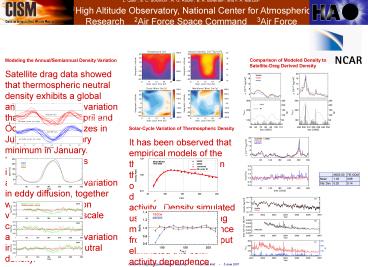Modeling Thermosphere Density and Temperature Variations - PowerPoint PPT Presentation
1 / 1
Title:
Modeling Thermosphere Density and Temperature Variations
Description:
Title: Slide 1 Author: Timothy Guild Last modified by: Stan Solomon Created Date: 12/1/2004 6:15:32 PM Document presentation format: Custom Company – PowerPoint PPT presentation
Number of Views:47
Avg rating:3.0/5.0
Title: Modeling Thermosphere Density and Temperature Variations
1
Modeling Thermosphere Density and Temperature
Variations L. Qian1, S. C. Solomon1, R. G.
Roble1, B. R. Bowman2, and F. A. Marcos3 1High
Altitude Observatory, National Center for
Atmospheric Research 2Air Force Space Command
3Air Force Research Lab
Abstract The NCAR Thermosphere-Ionosphere-Electro
dynamics General Circulation Model (TIEGCM) is
employed to quantify thermospheric neutral
density and its variations, focusing on the
global seasonal variation and the solar activity
dependence. Solar X-ray, extreme-ultraviolet
(EUV), and far-ultraviolet (FUV) spectral
irradiance measurements from the Solar EUV
Experiment (SEE) on the TIMED satellite are used
to drive the model. Density measurements derived
from the atmospheric drag on a set of 5 low-earth
orbiting satellites are compared to TIEGCM
results, and to the MSIS-00 empirical model.
Comparison of Modeled Density to Satellite-Drag
Derived Density
Modeling the Annual/Semiannual Density
Variation Satellite drag data showed that
thermospheric neutral density exhibits a global
annual/semiannual variation that maximizes in
April and October and minimizes in July with a
secondary minimum in January. TIEGCM simulations
indicated that an annual/semiannual variation in
eddy diffusion, together with annual insolation
variation and large-scale circulation, caused
annual/semiannual variation in thermospheric
neutral density.
Comparison of TIEGCM and MSIS00 to satellite
drag-derived density. Left solar rotational
variation during early 2003. Right geomagnetic
variation during the October-November Halloween
storms of 2003.
Annual/semiannual density variation detected by
satellite drag data Bowman, 2004
Solar-Cycle Variation of Thermospheric Density It
has been observed that empirical models of the
thermosphere based on the F10.7 index
overestimate neutral density at low solar
activity. Density simulated using the TIEGCM
using measured solar irradiance from TIMED/SEE as
input eliminated this solar-activity dependence.
Comparison of TIEGCM and MSIS00 to satellite
drag-derived density for the entire year of 2003.
Top density at perigee location. Bottom ratio
of model to measured densities.
An annual/semiannual variation of eddy diffusion,
comparable to observations and gravity-wave
breaking theory, were imposed at lower boundary
of the TIEGCM.
Ratio averages for all five satellites
MSIS-00 TIE-GCM
Mean 1.03 0.99
Std. Dev. 0.20 0.14
Ratio of satellite drag derived density to the
Jacchia 70 empirical model as a function of
F10.7, Marcos et al., 2005.
(a) Thermospheric neutral density near 400 km
from 2001 to 2006. The density is daily-averaged
density at satellite perigee locations. (b) The
TIMED/SEE integrated (5 nm to 105 nm) solar EUV
flux. (c) F10.7 index and Ap index.
Average ratio of satellite drag-derived density
to the TIEGCM simulated neutral density, for all
5 satellites. Green with effects from annual
insolation variation and large-scale circulation,
but with constant eddy diffusion Red added an
annual/semiannual variation of eddy diffusion.
Ratio of satellite drag derived density to the
TIEGCM and MSIS-00 models, from 2002-2004, as a
function of F10.7.
Center for Integrated Space Weather Modeling
Annual Site Visit 5 June 2007































